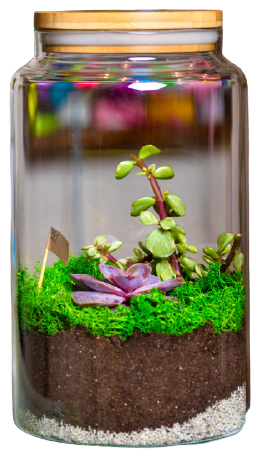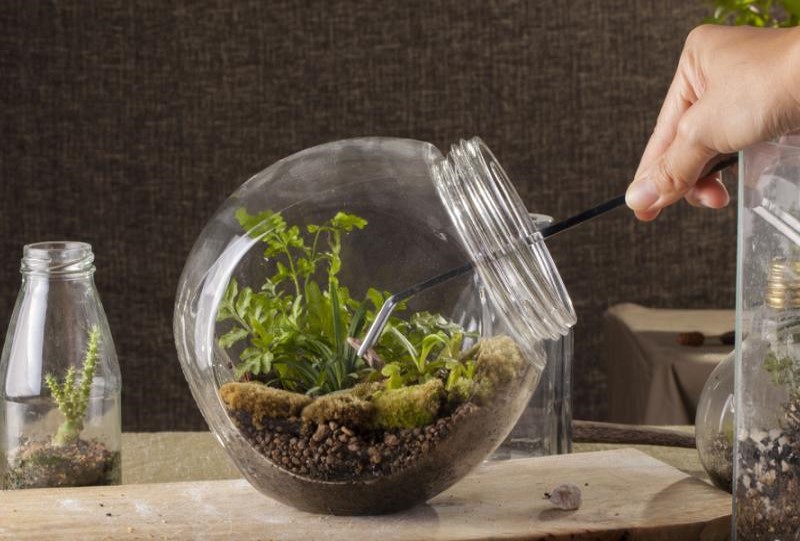What is a terrarium?
A terrarium is a miniature indoor garden inside a glass container. Terrariums are low-maintenance and are perfect for people who don’t have a green thumb or who don’t have time to care for an outdoor garden. They also add a bit of outdoor beauty and peace to desks, night tables, or any place where space is limited. To create your own terrarium, all you need are a few plants with similar light and water needs, a glass container, and some growing and drainage medium.




Materials
For setting up the terrarium :

a wide mouth will work well)





coco peat

For decoration :






Tips for Selecting Plants
- When choosing terrarium plants, make sure they are small enough to fit in your jar, preferably without touching the sides.
- If you have your heart set on, you can make beautiful terrariums with succulent plants. Make sure it is a topless terrarium and add clean, coarse sand is added to your potting mix.
- When considering terrarium plants, look for plants that like low to medium light. Get a mix of sizes, leaf textures, and leaf colours
- Select plants with similar needs. You can grow just about any low-maintenance plant in a terrarium, but you’ll need to choose plants that will grow well together.
- Get a selection of plants that grow in similar conditions in the wild, such as woodland, desert, or tropical plants
- Pick plants that stay small. Plants that grow really wide or tall aren’t the best options for terrarium gardens. Instead, stick to small, low-growing plants, or those that can be easily pruned down to their manageable sizes.
Steps for Making a Terrarium
Step 1:
• Add rocks to the bottom of the terrarium as the drainage layer.
• Pour some horticultural gravel or aquarium pebbles into the bottom of the container. While the amount you need to put in will vary depending on the size of your terrarium, a layer about 1 to 1.5 inches (2.5 to 3.8 cm) deep is usually sufficient.
• You could also use crushed pottery, rock chips, or even glass marbles for your drainage layer.
• This drainage layer is necessary to prevent the soil from becoming soggy in your terrarium, which can lead to problems with mould, bacteria, and root rot.
Step 2:
• Pour in a layer of activated charcoal.
• Activated charcoal acts as a filter in your terrarium, removing toxic chemicals from the water and soil.
• Put a layer about 1⁄2 inch (1.3 cm) deep on top of your drainage material.
• The charcoal is most effective if it sits on top of the drainage layer. However, if you’re working with a very small container, you can also mix the charcoal into the drainage material.
Step 3 (optional):
• Add sand after the charcoal layer .
• Lay down a layer of sand evenly across the terrarium. Sand comes in many colours and you can have fun with it. The thickness can be as per your choice.
• Sand acts as a transition layer between potting mix and the course charcoal and gravel layers.
Step 4:
• Add moss and then potting mix.
• The next step is to add moss on top of the stones and charcoal (if sand is not added). This is to keep your next layer, potting soil, from mixing in with the charcoal and stones. This is an aesthetic decision so this step is optional. It’s worthwhile because it can add visual interest to your terrarium.
• With a large spoon or small shovel, add potting mix on top of your moss or if you aren’t using moss, put the potting mix right on top of your charcoal or sand layer. Add as much potting mix as you can—at least a couple of inches. You will want to make sure your plants will fit into your terrarium with the top on, so you might have to hold your plants up to measure as you add soil
Step 5:
• Add plants and decoration.
• At this point, it’s important to think about the design of your terrarium. Will the terrarium have a back and a front? If so, you probably want to put your tallest plant in the back, or in the middle. You can also contour your soil so that it mounds and sinks to create interest.
• Dig small holes and carefully place your plants in the terrarium. It is time to get creative and add small decorations to your creation.

• If your terrarium is closed, take off the top at least once a month to air it out. If you see lots of condensation or have added too much water, leave the top off until it has had a chance to dry out.
• Pull off any leaves that show signs of yellowing or damage and prune plants if they grow too large. Don’t fertilize your terrarium, because you don’t want to encourage growth.
• Using a spray bottle or watering can with a rose attachment on the spout, water your terrarium. You don’t want it to be soaking wet, just damp. You can also use the spray bottle to clean off any dirt that has clung to the glass sides of your container, which you can then wipe clean with newspaper.
• Never use glass cleaner on the inside of a planted terrarium, as it could make your plants sick.

